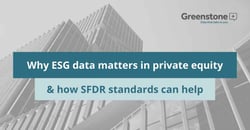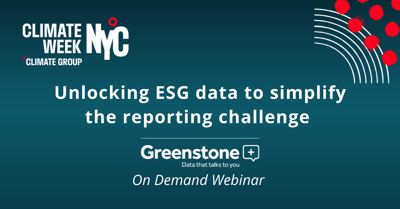Why ESG data matters in private equity & how SFDR standards can help
 The European Commission is soon expected to confirm the new Regulatory Technical Standards (RTS) that define the shape of the ‘level 2’ ESG disclosures required under the new Sustainable Finance Disclosure Regulation (SFDR) from 2022.
The European Commission is soon expected to confirm the new Regulatory Technical Standards (RTS) that define the shape of the ‘level 2’ ESG disclosures required under the new Sustainable Finance Disclosure Regulation (SFDR) from 2022.
In this blog post, we explore the metrics outlined in these standards, how the relevant data can be collected from portfolio companies, and how private equity managers can stay one step ahead by adopting these metrics to enhance their ESG capabilities.
What are the new standards under SFDR?
The new RTS are a list of 31 – 14 core and 17 additional[1] – standardised metrics of ‘principal adverse sustainability impacts.’ The required disclosures cover a broad range of key sustainability areas across Environment, Social and Governance (e.g. emissions, human rights and anti-corruption respectively).
Importantly, the standards include several key definitions, as well as details on how data should be aggregated up to the portfolio level – both of which are likely to become accepted standards. With reference to other key sources within European law, the framework provides definitions for traditionally ‘grey’ areas associated with categories such as biodiversity, as well as formulae for calculating portfolio-wide metrics such as carbon intensity and the gender pay gap.
Why ESG data matters to private equity
SFDR may be causing waves within public capital circles, but as reporting remains optional for many private equity houses, the sector risks remaining a step behind in the push for greater ESG transparency. Driven by increasing scrutiny from ESG-minded investors, however, there is growing recognition in the industry of the need for standardised ESG metrics. The new RTS look set to fill this role, with many other metrics and rating systems likely to fall in line around these new standards.
Alongside growing investor pressure, several other key factors are pushing PE firms towards SFDR-aligned ESG data collection and reporting:
- Value creation: as ESG has become better defined, a shift has taken place from risk mitigation to value creation, with proper ESG analysis and regular benchmarking recognised as being synonymous with the value creation purpose of a GP’s tenure. Granular ESG data can be used to identify weaknesses and steer improvements within PCs, especially on climate and biodiversity issues.
- Capital raising: ESG is now being demanded by Limited Partners, with a recent survey by Edelman showing that 88% of LPs globally consider ESG factors when making investment decisions. GPs who are able to prove their ESG credentials will be able to raise funds more easily in what is becoming an increasingly competitive space.
- Enhanced exit options: Weak ESG credentials were seen by many analysts to be a key contributing factor to Deliveroo’s recent IPO flop, with specific concerns around worker rights and corporate structure. Private companies are now expected to have attained a mature level of ESG competence before being taken public and good ESG ratings are now required by many exchanges.
- Public scrutiny: with many PE houses becoming signatories of the UN Principles for Responsible Investment (PRI), the public is shining a brighter light onto private capital, expecting the sector to adopt many of the enhanced ESG processes and commitments made in the public markets. Demonstrable, data-backed ESG improvements go some way towards winning public support and show that a fund is doing more than just making marketing claims.
How do I collect this data?
The new RTS present a major opportunity for private equity managers to enhance and standardise ESG data collection, allowing for greater benchmarking opportunities and enabling clearer communication to investors and other stakeholders. With this opportunity, however, comes the challenge of collecting and managing standardised data from a diverse range of portfolio companies.
Whilst PE firms are particularly adept at engaging with their portfolio companies, headaches may arise from data quality issues, as well as inconsistencies in data collection approaches between companies. For instance, in requiring a full breakdown of all greenhouse gas (GHG) emissions, including scope 3 from 2023, the requirements may prove particularly difficult for smaller companies with less mature environmental data collection and reporting.
With Greenstone’s InvestorPortal, managers can centrally coordinate the data collection process by distributing SFDR-aligned questionnaires to portfolio companies, monitoring engagement, and receiving portfolio-aggregated statistics. Detailed reporting guidance helps to ensure consistency and a robust approvals process ensures high data quality. For smaller PCs with less mature environmental reporting, the new ‘GHG emissions wizard’ allows PCs to calculate their scope 1, 2 and 3 emissions in a user-friendly manner, powered by our library of >1 million emissions factors.
[1] An additional 4 core metrics and 7 additional metrics may apply depending on whether the reporting organisation is invested in real estate assets or sovereigns. The 31 metrics included have been revised down from an initial list of 50 in the first draft of the RTS.
On-Demand Webinar | Unlocking ESG data to simplify the reporting challenge










